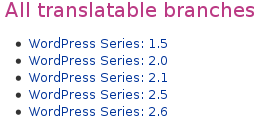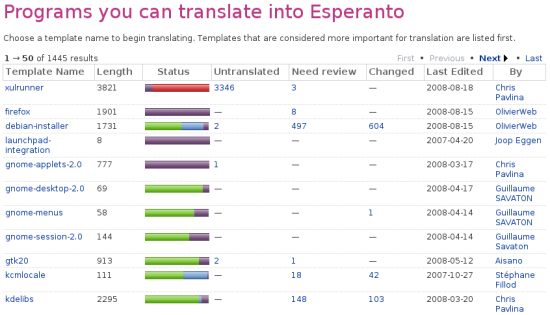|
Size: 8473
Comment:
|
Size: 8469
Comment:
|
| Deletions are marked like this. | Additions are marked like this. |
| Line 41: | Line 41: |
| = Where to start = | = Nereden başlanır = |
| Line 63: | Line 63: |
| == Making your first translation == | == İlk çeviriyi yapma == |
| Line 70: | Line 70: |
| In this example, you can see: | Bu örnekte, görebilirsin: |
| Line 93: | Line 93: |
| = Next steps = | = Sonraki adım = |
Launchpad Help > Translations > Starting to translate
Taktim
Özgür yazılıma yardım etmek için hem doğrudan öncelikli projelerle (Limewire gibi) hem de Ubuntu gibi dağıtımdaki paketlerle Launchpad'i kullanabilirsin.
Ne çevireceğine karar verdiğinde, aşağıdakileri düşün:
- Dağıtım paketinden daha çok öncelikli projede çalışabilir misin?
- Çevireceğin koşulların içeriklerini bilip, anlayacak derecede yazılım bilgisine sahip misin?
- Çeviri standartlarına uyacak kadar alışık mısın?
Projede uygulanan işlemler ve standartlar hakkında öğrenmek için, kendi dilindeki çeviri takımıyla iletişime geçebilirsin. Çoğu proje çeviri takımıyla çalışır - birçok takımın şemsiye organizasyonu - çeviri kalite kontroluyle ilgilenir. Her çeviri grubu belirli dillerle ilgilenen takımları belirler.
Not: Aşağıdaki çevirileri yapmak için takıma katılmana gerek yoktur: Onlar önizleme çevirilerine sahiptir.
Çeviri takımının neyi konuştuğunu bulabilirsin:
hangi çeviri grubunun proje ile ilgilendiğini kontrol etme - projenin çeviri önizleme sayfasını ziyaret et, örn. https://translations.launchpad.net/silva
- çeviri grubunun önizleme sayfasını ziyaret etme ve takım listesini okuma.
Takımla bağlantıya geçmeden önce, onlar sana standartlar ve onlarla mailleşme hakkında bilgi verecekler, IRC toplantıları vb.
Çevirilerin lisansı
One of Launchpad's terms of use is that you agree to license all your translations using the BSD license. This means that the translations you make are compatible with as many open source licenses as possible. There's more on this in our translations licensing FAQ.
Dağıtım paketleri ne zaman çevrilir
Ubuntu ve diğer işletim sistemleri (dağıtımlar) kullanıcılarının yazılımları çevirmeleriiçin Launchpad'i kullanmalarına imkan verirler. Bu dağıtımlar öncelikli projelerden çalışır ve onu değiştirmek genellikle alt yöntemlerde sistemlerinin ve kullanıcılarına uygun olarak yapılır.
Only when you understand the rules, standards, and complexities of translating that particular package and you know why the distribution translation needs to differ from the upstream one, should you translate a distribution's package of a project
If the software you want to translate is available to translate both directly as an upstream project (whether inside Launchpad or not) and as a distribution package within Launchpad, you should talk to the upstream project and the relevant Ubuntu translations team to see where your help is most needed.
If you choose to translate Ubuntu packages, you may find the Ubuntu community's guide to translating Ubuntu helpful.
Nereden başlanır
|
Translatable series for Wordpress |
Once you've been in touch with the relevant translation team, to learn their standards etc, you can start translation straight away. You don't need any special software or, in most cases, special permissions: all you need are your Launchpad account, your web browser and your translation skills!
When you're ready to get started, you need to tell Launchpad which languages you want to work with. Next, choose:
upstream project: which line of development to translate; usually it'll be whichever is selected by default when you visit the project's translations overview page but check with the project
distributions, such as Ubuntu: which package you're going to translate.
Launchpad makes it easy to choose a distribution package by showing which packages are most in need of your help.
|
Esperanto translation progress of Ubuntu packages |
Red represents untranslated strings, whereas green, purple and blue represent translated strings; Launchpad uses different colors for translated strings to help you distinguish where and when the translation was made.
|
Translation progress bar key |
İlk çeviriyi yapma
Click on the package or project language that you want to translate and you'll see that each original English string has a section of the page. Let's take a look at the Esperanto translation of Ubuntu's ''xulrunner'' package.
|
Making a translation |
Bu örnekte, görebilirsin:
- the original English string
- a note on the string's context, to help you translate it more intelligently
- any current translation
- automatic suggestions: Launchpad looks through its database of millions of translated strings to see if that English string has been translated into Esperanto elsewhere
- a text box, in case a new or altered translation is necessary
- a note about which file the string appears in.
If you find a string that hasn't been translated or that you are certain has been translated incorrectly, you should
Dealing with unusual characters
In many cases, your translation will be a straight conversion from English to the target language. However, from time to time you may come across unusual characters and character sequences. These are usually variables, formatting or keyboard shortcuts.
How you handle them in your translation depends on what they are:
Formatting: you may see HTML, such as <strong>, used to format text in a string. Copy these tags exactly as you find them and apply them to the relevant part of the text, remembering to close the tags as appropriate. You may also see other tags, such as XML, and should treat them the same way.
Data placeholders and variables: in many development languages, a developer can insert data into a string by using a placeholder such as %s or %d. You may also see more complex variations, such as %(variablename)s, $name or ${name}. Copy these variables and placeholders exactly as you see, placing them in whichever part of the string makes most sense in the target language. If you're in doubt, ask another translator for advice.
Keyboard shortcuts: different development languages and frameworks use different ways to signify which key within a string should be used as a keyboard shortcut. Very often, if you see an underscore (e.g. Save _As) or ampersand (e.g. Print previe&w) at the beginning or within a word, it may well be a keyboard shortcut. Ensuring you have a unique shortcut for each function is important and you should, at the very least, view the software in action and draw up a list of the shortcuts you plan to use before you start translating. You should place the underscore, ampersand or whichever other control character directly in front of the letter you want to use as the shortcut.
If you're unsure, speak to someone from the relevant translation team; they'll be glad to help.
Sonraki adım
Read the general translation guidelines and know how to organize a localization team.
 launchpad help
launchpad help



